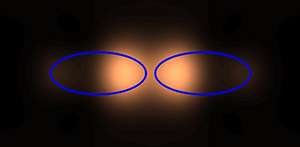Optics: Nanotechnology's benefits brought into focus

Conventional lenses, made of shaped glass, are limited in how precisely they can redirect beams of incoming light and make them meet at a point. Now, a team led by Zhengtong Liu at the A*STAR Institute of High Performance Computing, Singapore, has proposed a novel approach to 'superlens' systems that can surpass this classical limit of focusing light.
The team used numerical modeling to develop the design. Concentrating radiation into a smaller volume in this way enhances the interaction between light and matter, and thus the concept could prove useful in highly sensitive sensors of the future.
Light is a type of wave. Unlike the rise and fall in sea water at a beach, however, a light wave consists of oscillating electric and magnetic fields. The wavelength—the distance a wave travels in one oscillation cycle—imposes a limit on the minimum size to which light can be focused. However, this limit does not apply over small distances that are comparable to the wavelength, which is known as the near-field regime.
The researchers designed a silver nanostructure embedded in glass. Their device combined two separate elements. One component was a nanoantenna—similar to the radio-frequency antennas used to detect television-carrying signals, but reduced in size to match the wavelength of optical radiation. The other component was a superlens made of a thin slab of silver. The purpose of the superlens was to move the light detected by the nanoantenna into an imaging plane. "Using nanoantennas to concentrate light is not a new idea," says Liu. "But by adding a superlens to translate the concentrated spot of light, we can overcome limitations imposed by the optical properties of the material."
Liu and co-workers mathematically modeled the optical response of this device to an incoming beam of red light. They then altered the dimensions of the structure to maximize the enhancement in electric field. In this way, they were able to show that a 20-nanometer-thick superlens, separated by 34 nanometers from an antenna made of two silver ellipses, could increase the electric field of light by a factor of 250 (see image).
Confining light into these super intense 'hot-spots' could prove a boon for optical detection systems. "Our concept is targeted at biomedical and chemical sensing applications," explains Liu. "The next step is to seek collaboration opportunities to actually make the sensor and test it in the field."
More information: Liu, Z., Li, E., Shalaev, V. M. & Kildishev, A. V. Near field enhancement in silver nanoantenna-superlens systems. Applied Physics Letters 101, 021109 (2012). dx.doi.org/10.1063/1.4732793
Journal information: Applied Physics Letters





















